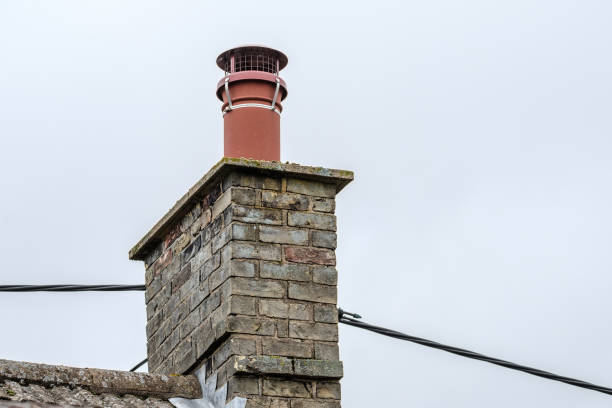A properly functioning chimney is crucial for home safety and heating efficiency. However, over time, chimneys can develop issues that, if left unattended, can lead to costly repairs or even hazardous conditions. Identifying early signs of chimney damage can help homeowners take proactive steps to maintain their chimney’s integrity and avoid major problems. This article outlines the most common signs that indicate your chimney may need repairs and how to address them effectively.
1. Cracked or Damaged Chimney Bricks and Mortar
One of the first visible signs of chimney deterioration is cracked or missing bricks and deteriorating mortar. Exposure to harsh weather conditions, moisture, and temperature fluctuations can cause these structural components to weaken over time. If left unaddressed, this can lead to:
- Water infiltration, which accelerates damage.
- Structural instability, increasing the risk of chimney collapse.
- Heat and smoke leakage, posing a fire hazard.
Solution: If you notice cracks or crumbling mortar, schedule a professional inspection to assess the damage. Tuckpointing, a process of replacing deteriorated mortar, can help restore structural integrity.

2. White Staining (Efflorescence)
White, powdery stains on the exterior of your chimney, known as efflorescence, indicate excessive moisture inside the bricks. While the stain itself is not harmful, it suggests underlying water penetration issues that can lead to serious damage over time.
Solution: Waterproofing your chimney and fixing any water entry points, such as cracks or gaps, can help prevent further moisture-related damage.
3. Rust in the Firebox or Chimney Damper
Rust inside your chimney or on the damper indicates excess moisture. A chimney should be completely dry; rust suggests that water is seeping in, which can lead to:
- Deterioration of metal chimney components.
- Mold and mildew growth.
- Damage to the chimney liner, reducing efficiency and safety.
Solution: Check for leaks and repair any damaged flashing or chimney caps. Installing a properly fitted chimney cap can help prevent water from entering the chimney.
4. Spalling Bricks
Spalling occurs when water enters the bricks and causes them to flake, peel, or break apart. This is a clear sign of moisture damage and, if ignored, can weaken the entire chimney structure.
Solution: Replace damaged bricks and apply a waterproof sealant to prevent further moisture absorption. Regular maintenance is crucial to extending the life of your chimney.
5. Damaged or Missing Chimney Cap
A chimney cap serves as a protective cover that prevents debris, rain, and animals from entering your chimney. If your chimney cap is damaged or missing, you may experience:
- Blockages from debris or nesting animals.
- Increased moisture infiltration.
- Higher risk of chimney liner damage.
Solution: Inspect your chimney cap regularly and replace it if it's broken or missing. A stainless steel chimney cap is a durable and long-lasting option.
6. Smoke Entering Your Home
If smoke is backing up into your home rather than venting properly, your chimney may have a blockage or drafting issue. Common causes include:
- Creosote buildup restricting airflow.
- Animal nests obstructing the chimney.
- Damaged flue liner preventing proper venting.
Solution: Schedule a professional chimney cleaning to remove blockages and inspect the chimney’s draft system. Installing a proper chimney liner can also improve efficiency.
7. Unpleasant Odors from the Fireplace
Foul or musty smells coming from your fireplace are usually a sign of moisture, creosote buildup, or animal activity. Common causes include:
- Excessive creosote deposits, which can emit a strong, smoky odor.
- Moisture absorption leading to mold and mildew growth.
- Dead animals or nesting materials causing decay smells.
Solution: Regular chimney cleaning and waterproofing can help eliminate odors. A well-fitted chimney cap will also prevent animals and debris from entering.
8. Deteriorating Chimney Crown
The chimney crown is a concrete or stone slab at the top of the chimney that helps protect against water infiltration. Over time, exposure to harsh weather can cause it to crack and deteriorate, allowing moisture to seep into the chimney structure.
Solution: Inspect the chimney crown for cracks and apply a waterproof sealant. If the damage is severe, a professional may need to replace it entirely.
9. Water Leaks Around the Fireplace
If you notice water stains on your ceiling or walls near the fireplace, it may be due to a leaking chimney. This can be caused by:
- Damaged chimney flashing (the seal between the chimney and roof).
- Cracks in the chimney structure allowing water intrusion.
- Missing or broken chimney caps or crowns.
Solution: Address leaks immediately to prevent further structural damage. Repairing flashing, sealing cracks, and applying a chimney waterproofing treatment can help resolve the issue.
10. Unstable or Leaning Chimney
A chimney that appears to be tilting or leaning is a serious structural issue that requires immediate attention. This may be due to:
- A weak or deteriorating foundation.
- Severe water damage weakening the masonry.
- Erosion of the soil supporting the chimney base.
Solution: Contact a professional masonry contractor immediately. A leaning chimney may need reinforcement or even complete reconstruction to prevent collapse.
Regular chimney inspections and maintenance are crucial for preventing costly repairs and ensuring the safety of your home. By keeping an eye out for these warning signs—such as cracks, moisture damage, and drafting issues—you can address minor problems before they turn into major hazards. If you suspect chimney damage, don’t hesitate to consult a professional chimney repair service to ensure your home remains safe and efficient.







